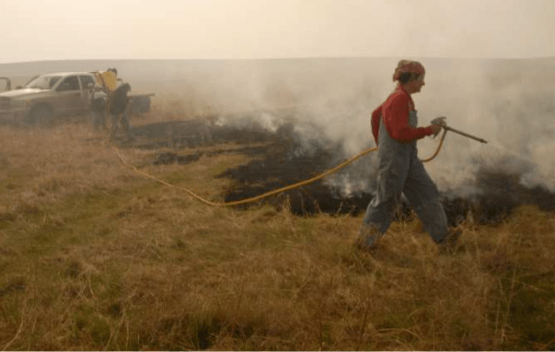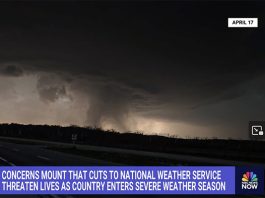
Ranchers on the tallgrass prairie traditionally burn their pastures each spring before summer grazing. After fire, plants grow more quickly, and the new growth is very nutritious. But the practice is problematic for migratory birds. It reduces nesting and feeding habitat just when they need it most. So, how can ranchers balance getting great forage while maintaining wildlife habitat? Jane Koger, a rancher in Matfield Kansas suggests that patch-burning is a good option.
Instead of burning an entire pasture, patch-burns focus on a portion of the pasture. Generally, one-third of each grazing unit is burned annually in rotation. Post-fire regrowth attracts cattle to burned areas where forage is most nutritious. The remainder of the pasture is only grazed lightly. This lets plants rest and build root mass while providing the habitat that wildlife prefer.
The Homestead Ranch Renewal Initiative
In 2003, Koger created the Homestead Ranch Renewal Initiative, the first, privately-sponsored effort to explore how patch-burning might benefit ranchers and the prairie. She brought together an advisory team that included representatives from the U.S. Fish & Wildlife Service, Natural Resources Conservation Service (NRCS) and The Nature Conservancy, to develop a plan to improve wildlife habitat, and to revitalize Homestead Ranch pastures.
 The next spring, the team began patch-burning a third of each of three 900-acre pastures, using a burn plan developed with the NRCS. The plan used an aerial mapping system to segment Koger’s acreage using natural borders like roads and low-lying areas where water accumulates.
The next spring, the team began patch-burning a third of each of three 900-acre pastures, using a burn plan developed with the NRCS. The plan used an aerial mapping system to segment Koger’s acreage using natural borders like roads and low-lying areas where water accumulates.
Good for Grazing Management
The objective of a patch burn grazing system is to use fires to focus livestock grazing in scattered patches across a single grazing unit. The effect is a range of heavy grazing to virtually no grazing within the same unit, without the use of interior fencing.
“It’s what the Native Americans did to attract the buffalo,” Koger says. Historically, bison would congregate on burned areas to take advantage of the new, green grass, and cattle behave the same way. In fact Koger found that her herd spent 80 percent of their time in a just-burned patch. That meant the remainder of the pasture could rest and grow. “It’s not just about what we burn, it’s about the two-thirds of the pasture that we don’t burn too,” said Koger. “It’s about getting the grass rest.”
And the system appears to also benefit forage, as livestock gains on patch burning systems are even with those on traditional systems.

Good for the Cattle
 Koger’s goal for her project was to show ranchers you can have a profitable operation while conserving habitat for wildlife. So making sure that cattle productivity did not suffer was key. During the project, which ran from 2004 to 2010, Koger ran and monitored three different grazing scenarios:
Koger’s goal for her project was to show ranchers you can have a profitable operation while conserving habitat for wildlife. So making sure that cattle productivity did not suffer was key. During the project, which ran from 2004 to 2010, Koger ran and monitored three different grazing scenarios:
1) double-stock yearling stocker cattle (April – July),
2) full season yearling stocker cattle (April – October) and
3) year-round cow/calf.
Research in this project and in two trials in Oklahoma has shown that cattle on patch burn-grazed native grasslands have gains comparable to those cattle in the traditional intensive grazing system. The increased plant diversity that results from patch burning may also be a plus for livestock health.
Good for the Birds
A patch burn area may appear to be mismanaged and underutilized. However, this untidy appearance is precisely what provides habitat for grassland wildlife. The burned tract provides better nesting and foraging habitat, and discourages growth of trees and shrubs that could shelter predators such as raccoons, coyotes, and raptors. Grassland birds need large, treeless, open areas of prairie to flourish.
The Homestead Ranch demonstrates the success of patch burning for improving habitat. Koger says there are now more bobwhite quail, eastern meadowlarks, grasshopper sparrows and greater prairie chickens. The Henslow’s sparrow has also been sighted, a unique harbinger of prairie integrity, because it only chooses unburned, lightly grazed native prairie.
How Can You Get Started?
If all this seems complicated to you, you’re right. It requires planning and understanding of fire behavior. But the good news is that there are agency partners willing to assist you with the process and implementation. To get an idea of what is involved, here’s an excerpt from a Natural Resource Conservation Service Patch Burn Grazing Information Sheet:
Developing a Patch Burn Grazing System

It will take a minimum of three years to complete a patch burn grazing cycle, burning one-third of the unit each year. However, wildlife and cattle will benefit the first year. Before starting the cycle, resting a portion of the unit for part of the growing season may be necessary to build-up adequate fuel loads to be burned the first year. A minimum of 30 contiguous acres to be burned might be preferred to provide ample nesting cover for grassland birds. Before starting a patch burn grazing system, managers should evaluate their present goals and current stocking rates to determine if this type of system will work for them. If overstocked, adequate fuel for burning may not be available and this system will not work.
First, ensure proper stocking rates are in place that allow for needed fuel loads. If the grazing unit as a whole is lacking in adequate fuel, this can be a sign that stocking rate needs to be adjusted.
In July of each year, evaluate the current herbaceous fuel loads in the grazing unit and determine availability at time of planned prescribed burn. At least 3 – 5 inches of continuous residual plant material must be present to carry a fire at the time of the burn. If fuel will be lacking, re-evaluate stocking rate and make needed adjustments.
Conduct a prescribed burn on the excluded area of the unit in late winter to early greenup of the warm season grasses. (Usually sometime between the dates of January 1st to May 1st). Prescribed burns should be conducted at a time of the year to stimulate grass production. Consider topography, surrounding vegetation, natural and man-made firebreaks and proximity to buildings and other structures when conducting prescribed burns. Landowners should request an approved prescribed burn plan before conducting a burn.
If currently using a continuous stocking system where livestock are not moved through multiple paddocks, livestock will remain in the burned unit at all times. Livestock will not need to be moved and forage is available to graze in other areas until greenup following the prescribed burn. At that time, grazing will shift to the recently burned area.
If using a multiple paddock grazing system where livestock have been traditionally rotated, livestock can be excluded from the burned area if needed until the desired time until there is adequate forage in the burned portion of the unit, generally about 6 inches or more of growth.
The second year, conduct a prescribed burn on another portion of the unburned area from last year. Repeat the process described above. During the second year,cattle will graze primarily in the newly burned area, while the previous year’s burned area and the remaining un-burned area are only used occasionally.
Repeat the cycle of burning for the remaining years until each portion has been burned. Then the cycle will repeat.
Where Can You Get Assistance?
Talk to the folks at your local Natural Resources Conservation District office or Conservation District office. They can help you identify resources, potential financial assistance and help with the planning process.





Great article, Kathy. So glad to see it. I know Koger well. Her brother, Ed, also practices pbg in the Red Hills of southcentral-southwest Kansas. It has shown remarkable recovery of lesser prairie chickens and redcedar control which is a real menace. Thanks for publishing this.
I think it’s the font, but the aerial photo caption looks like it says
“one third bum sectors.” In Canada a bum is not a hobo, or a vagrant, or what my dad sometimes called me when I didn’t do my chores. . . . In Canada a “bum” is what in the U.S. we used to call a person’s butt. I believe they are divided into two sectors, not three.
I wonder how they control these fires if there are gusts of wind?
Comments are closed.